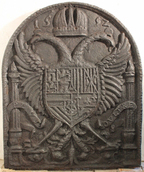-
995
Description: Arched; fillet edging; English royal Stuart shield, garter, crown, supporters, 'CS' monogram to left of Garter buckle, and motto on a cartouche; small rose stamp repeated each side of crown; date split each side of top of crown (first part absent in this casting).
Notes: Although English arms, the design is in a continental style, arched firebacks being typical of Lorraine; the 'CS' monogram is likely to be that of the pattern-maker; a modern copy of a poor casting, hence the incomplete date. For the complete version see no. 994.
Copies of this fireback are known.
Inscription: [16 missing] 21 / HONI SOIT QVI MAL Y PENSE / CS / DIEV ET MON DROIT
Arms: English Stuart royal (James I)
- Decoration tags:
- rounded arched (shape)
- cavetto (edging)
- whole carved pattern
- planklines
- monogram
- armorial
- royal
- text
Manufactured: in 1621 in England.
Current location: not known.
- Attached to series:
- Jacobean royal armorial firebacks
- Stuart royal armorial firebacks
-
10
Description: Rectangular; rope edging (top and sides); central Tudor royal shield with encircling garter (motto reversed: HONE SOVT QVEY … PEN), separate greyhound and lion supporters, separate crown; a bird, repeated in each top corner, its wings displayed and inverted and its head facing behind and to the left, standing on a scroll; a fleur de lys repeated in the bottom corners; inside the birds is a repeated stamp, half of one similar to a stamp on a fireback in Hastings Museum.
Notes: The particular form of the Tudor arms and supporters is encountered on other firebacks, as are the distinctive style of fleurs de lys and the birds (probably swans, a Lancastrian icon). The plain scroll upon which the bird is perched suggests that there might have been a painted inscription on it originally and that the stamp had not been made specifically for the decoration of firebacks but was, perhaps, redundant from interior domestic decoration. Formerly at Framfield, East Sussex.
Arms: Tudor royal (prob. Henry VIII)
- Decoration tags:
- rectangular (shape)
- rope (edging)
- carved stamps
- heraldic
- armorial
- royal
- objects
Manufactured: in the early- to mid-16th century possibly at Pounsley Furnace, Framfield in the Weald area of England.
Current location: The Clergy House, Alfriston, East Sussex, England.
Museum number: 200044 (part of the National Trust museum group)
-
1135
Description: Arched shape; fillet edging; top centre, date; decorative Tudor royal shield, crown, garter (motto clockwise but reversed) and supporters (dragon and greyhound); a rose to the left and a portcullis (grid of 6) to the right side of crown; the supporters stand on a horizontal compartment which, on similar firebacks, often contains the date.
Notes: There are several firebacks with the Tudor royal arms that were probably originally produced in the Spanish Netherlands, perhaps illustrating the association between England and Spain through the marriage of Henry VIII and Katherine of Aragon. The firebacks differ in several small details, such as the form and rotation of the Garter motto, the style of the crown, the positioning of the supporters in relation to the Garter, and the form and size of the rose and portcullis.
Inscription: 15 70 / HONY SOYT QVI MAL Y PENSE
Arms: English royal Tudor
- Decoration tags:
- rounded arched (shape)
- fillet (edging)
- whole carved pattern
- individual numbers
- heraldic
- armorial
- text
Manufactured: in 1570 possibly in the Wallonia area of Luxemburg.
Current location: Antique-fireback.com (www.firebacks.net/) 21 Nederstraat, Amerongen, Utrechtse Heuvelrug, Netherlands.
- Attached to series:
- Tudor royal armorial firebacks
- Continental Tudor royal armorial firebacks
-
145
Description: Arched shape; cavetto moulded edging; shield, crown, tassels and ribbons, of the combined kingdom of Castille, Aragon, Leon and Sicily.
Notes: Probably the arms of King Charles V of Spain; quarterly (1 & 4) Castille and Leon, (2 & 3) Aragon and Aragon-Sicily.
Inscription: 15 [?]0
Arms: Royal House of Trastámara (Spain)
- Decoration tags:
- rounded arched (shape)
- cavetto (edging)
- whole carved pattern
- armorial
- royal
Manufactured: in 1550 probably at Eisenschmitt Furnace in the Eifel area of Germany.
Current location: in private hands, Érezée, Luxembourg, Belgium.
- Attached to series:
- Foreign armorial firebacks
-
1231
Description: Arched rectangular shape; ovolo-moulded edging; shield, Garter, crowned helm and mantling of the English royal arms to 1603 with crowned lion and griffon supporters standing on separate rectangular cartouches containing the word 'ANNO' and the date '1662'; above the mantling are the initials 'I R'
Notes: The date appears to have been altered from 1602. The initials 'I R' for Jacobus Rex (James I of England) are inappropriate for the date in both its original and its altered form; also the griffon supporter on the sinister side is incorrect, a dragon being correct for the arms of Elizabeth I in 1602. There is a vertical plankline left of centre.
Inscription: I R / HONI SOIT QVI MAL I PENSE / ANNO 1662
Arms: English Tudor royal
- Decoration tags:
- rounded arched (shape)
- ovolo (edging)
- whole carved pattern
- individual letters
- planklines
- heraldic
- armorial
- royal
- text
Manufactured: in 1662 possibly in the Ardennes area of Belgium.
Current location: Rijksmuseum, Museumstraat, Amsterdam South, North Holland, Netherlands.
Museum number: BK-NM-10837 (part of the Rijksmuseum museum group)
-
1288
Description: Arched rectangular shape with rounded corners; ovolo within fillet moulding all round; oval Tudor royal shield with garter surrounding, topped with a royal crown; dragon and greyhound supporters; initials split by crown; inscription on a fillet between legs of supporters, behind garter finial; motto on an Ionic plinth at bottom; two rectangular side panels with twisted rope edging top and side.
Notes: The supporters are those of Henry VII or Henry VIII, but the initials suggest the fireback dates from the reign of Edward VI (1547-53). John Harvo (d. c1565) was a gunfounder who has been identified as occupying Pounsley furnace, Framfield, Sussex, possibly from as early as 1547; the fireback may have been cast originally during the reign of Henry VIII (1509-47), with the initials added to an early casting using the original pattern. The detail on the armorial back is good, showing little wear, so the casting was probably made not long after the original armorial fireback. The rivets are modern.
Inscription: E R / HONY SOIT QVE MAL Y PAYNCE / Made in Sussex by John Harvo / DV ET MOVN DROI
Arms: Tudor royal - Probably Henry VIII
- Decoration tags:
- rectangular with round arch (shape)
- rope (edging)
- simple stamps
- whole carved pattern
- heraldic
- armorial
Manufactured: in the mid- to late-16th century in the Weald area of England.
Current location: not known.
- Attached to series:
- John Harvo series
- Pounsley series
-
1139
Description: Carved wooden fireback pattern. Arched rectangular shape; fillet edging to a rounded frame with sections of acanthus leaves at the corners and at the top of the arch, and blank campartments in between; astragal and fillet inside edging; arched rectangular inscription scroll suspended with faux ribbon from the top of the arch; below, a coronet over a large baroque cartouche containg two oval shields: Massenbach - azure two bars or, d'Helmstadt - argent a crow sable; on either side, lion rampant reguardant supporters; four vertical planklines.
Notes: A finely executed carving. Nicolas de Massenbach (1659-1722) and Francoise d'Helmstadt (d.1729) were married at Ourches-sur-Meuse, in Lorraine, in 1695.
Inscription: NDM 1710 FDH
Arms: Nicolas de Massenbach and Francoise d'Helmstadt
- Decoration tags:
- rectangular with round arch (shape)
- fillet (edging)
- whole carved pattern
- planklines
- heraldic
- armorial
- text
Manufactured: in 1710 in France.
Current location: not known.
Citation: Palasi, P., 2014, Plaques de Cheminées Héraldiques (Paris, Éditions Gourcuff-Gradenigo).
- Attached to series:
- Patterns
-
932
Description: Carved wooden fireback pattern. Canted arched rectangular shape with cavetto-moulded astragal edging; coronet in arch; oval shield with a crowned lion lion rampant, supported two griffons reguardant, the whole within a cartouche, the bottom of which terminates in two swirls between which is a human mask.
Notes: Theodore Agrippa d'Aubigné
Arms: Theodore Agrippa d'Aubigné
- Decoration tags:
- rectangular with canted top corners and round arch (shape)
- astragal with cavetto (edging)
- whole carved pattern
- planklines
- armorial
Manufactured: in the early-17th century in France.
Current location: not known.
Citation: Carpentier, H., 1912, Plaques de Cheminées (Paris, published by the author).
- Attached to series:
- Patterns
- Personal armorial firebacks
-
627
Description: Arched shape; cavetto moulded edge; double-headed eagle displayed, a Holy Roman Imperial crown above; in front, a quartered shield; a flaming pillar on each side, a motto scroll entwining each.
Notes: The shield bears the arms of Charles V, Holy Roman Emperor (reigned 1519-1556), king of Spain and nephew of Katherine of Aragon, Queen of England; the pillars are a symbolic representation of the Pillars of Hercules at the Strait of Gibraltar. Some variants of this fireback have a different date (e.g. see no. 1267) or none at all.
Copies of this fireback are known.
Inscription: PLVS OVLTRE [Further Beyond]
Arms: Charles V, Holy Roman Emperor
- Decoration tags:
- rounded arched (shape)
- cavetto (edging)
- whole carved pattern
- individual numbers
- heraldic
- armorial
- royal
- text
Manufactured: in 1592 possibly in the Eifel area of Germany.
Current location: Ashbourne, Derbyshire, England.
- Attached to series:
- Foreign armorial firebacks
-
849
Description: Rectangular with superimposed arch; embattled, cavetto moulded edging, with the top edge of the rectangle interrupted; shield, garter, crown, supporters and motto of the English Royal house of Stuart; rose and thistle plants above lion and unicorn supporters respectively; initials split by crown; date below garter.
Notes: A version dated 1619 is proportioned slightly differently and has smaller rose and thistle plant stamps.
Copies of this fireback are known.
Inscription: I R / 16 21
Arms: English Stuart royal - James I
- Decoration tags:
- rectangular with round arch (shape)
- embattled cavetto (edging)
- whole carved pattern
- armorial
- royal
- text
Manufactured: in 1621 in England.
Current location: in private hands, Ashurst, West Sussex, England.

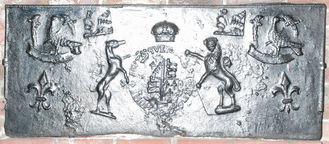

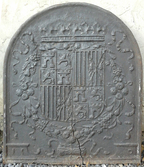
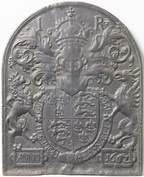
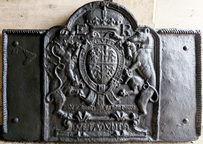
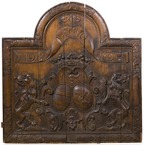
 carpentier p229 690x870.png)
